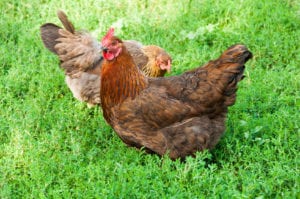
This is a common problem in pet and backyard chickens, and there can be several causes.
Firstly, make sure your chickens are getting a high quality, well balanced diet with enough, but not too much, calcium for eggshell production. This is especially important if you have red layer hens (either Hyline Browns or Red Shavers) as these breeds have been genetically selected for extremely high egg production, and they can’t do this without the correct feed. The best feed is a commercially prepared layer feed, either mash or pellets. These feeds are carefully formulated to contain everything that laying hens need. Chickens love other items, such as silver beet, insects and wheat, but this does not mean that these are the best foods for them. Feed the layer feed first thing in the morning, and make sure the feed bowls are clean, and there are enough feeding places for all the hens to get access. One or two bully hens can prevent those further down the pecking order from getting enough food. Then, once the hens have filled up on nutritious feed, you can supplement them with other foods if you wish. If you feed everything together, they may pick and choose and not get a balanced diet. Very similar to children at a birthday party – the vege sticks are not the most popular food, even though they are the most nutritious!
As your hens get older, they lay larger eggs, but there is only the same amount of shell material to go around it, so the shells will naturally be a bit thinner and more easily broken. Ensure plenty of clean nests (no more than five birds per nest) to reduce egg trampling. The nests need a soft base, so at least 5cm of clean shavings, for eggs to land softly. Keep your nests and coops free of parasites, which irritate the birds while they are laying, and may lead to damaged eggshells. Consult your vet about red mite and internal parasite control. Trim hens’ toenails if required.
Stage of lay affects shell quality. When hens first start to lay, the complex process of egg formation may take a few days to settle into a normal pattern, so small eggs, eggs without shells and double yolk eggs are more common at this time. This applies to pullets just starting to lay, and older hens resuming lay after a moult.
Disease: there are two diseases which commonly cause abnormal shells in eggs: infectious bronchitis and egg drop syndrome. These are best avoided by keeping your hens’ environment clean and tidy, regular disinfection with a broad spectrum disinfectant such as Virkon, and avoiding contact with other chickens, which could carry these diseases. Vaccination is not practicable for small numbers of hens but could be considered for larger flocks. Consult your vet about vaccination of chickens.
Feeding hens during rearing and during a moult: chickens contain about 40grams of calcium in total, and each egg contains about 4gm of calcium in the shell. This is a lot on a daily basis for the hen to produce, and she backs up any daily deficit by using calcium from her bones. Chicks must be reared on good quality feed (chick feed, NOT layer feed, which is far too high in calcium for young birds), so they can store enough calcium in their bones for later use in shell production. Likewise, hens need good food during their moulting period, so they can replenish calcium lost from the bones during a long laying period.
Written by Dawn Mills BVSc
